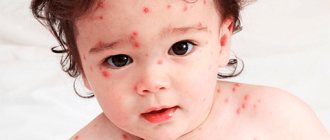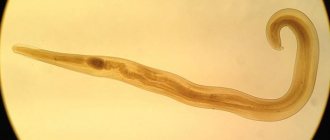Rubella symptoms
The incubation period for rubella lasts from 10 days to three weeks. The disease can be asymptomatic, manifesting itself on the fifth day - only after the appearance of rashes. After two days, fever may occur with a rise in temperature to subfebrile levels. In some cases, deterioration in health, headache, runny nose, and loss of appetite may occur two days before the onset of the rash.
It is not difficult for a doctor to make the correct diagnosis. It is enough for him to see the rash on the body to understand what kind of infection caused it. If doubts remain, the doctor will refer the patient for testing. This will confirm the diagnosis. The patient will need to donate blood, which will be sent for ELISA.
The most characteristic symptom of rubella in adults - a rash - is usually more pronounced than in children; individual elements of the rash can merge with each other, forming larger erythematous spots.
Small pink spots first appear behind the ears and on the nose, after which they spread to the arms and torso, eventually moving to the lower extremities. When merging, the color of the spots becomes darker, which lasts 1.5 weeks. At the same time, adults experience general malaise, body temperature rises, and patients are bothered by headaches, pain in joints and muscles. In most cases, the disease is accompanied by a profuse runny nose and sore throat.
In addition to the appearance of a rash, a person’s lymph nodes increase in size. This is due to the accumulation of a large number of viruses in them. The nodes located on the back of the head swell especially intensively. This symptom helps confirm the diagnosis.
From the moment of infection until the first symptoms appear, about 10-25 days pass. A person will begin to spread the infection 1 day before the first elements of the rash appear. It remains contagious for 7 days after its onset.
Diagnostics
The most reliable laboratory methods for diagnosing rubella are virological and molecular biological (PCR) analysis. The virological method is based on the isolation of viruses from swabs from biological fluids:
- saliva;
- blood;
- feces;
- urine, etc.
The virus can be detected by infecting a cell culture. The PCR method allows you to detect viral DNA in all of the above-mentioned biological fluids. Both methods can be applied to patients with both acquired and congenital forms of rubella.
However, the virological method is almost never used in practice due to its complexity and high cost. The PCR method is mainly used to diagnose congenital rubella. In newborns and children under 1.5-2 years of age, the material for research is blood and nasopharyngeal swabs; urine analysis is less often performed.
In the perinatal period, from the 11th week of gestation, the amniotic fluid of the pregnant woman is examined, and from the 22-23rd week, amniotic fluid and umbilical cord blood are examined. These materials for analysis can be obtained by amniocentesis and cordocentesis.
In clinical practice, the most widely used serological methods for diagnosing rubella are blood tests for antibodies to the virus. The presence of specific antibodies indicates that at the time of blood collection the patient’s body is fighting this disease.
The study results are assessed taking into account the characteristics of the body’s immune response to the penetration of viruses. This allows us to differentiate the acute process from immunity and reinfection. Using this analysis, it is also possible to diagnose intrauterine infection of the fetus.
It has been established that with acquired rubella, specific antibodies to the virus appear in the blood from the first days of the disease. This means that you can go to the doctor immediately after the first symptoms appear. After all, the sooner a diagnosis is made and a treatment regimen is prescribed, the better. This is especially true for pregnant women.
Antibodies reach their highest concentration in the patient’s blood three to four weeks after infection. After this, their level gradually decreases. Finally, antibodies cease to be detected only after three months, that is, they can be detected in the blood even after complete recovery.
Regardless of the form of rubella infection, specific antibodies in low concentrations are found in a person’s blood for life. Acquired immunity is developed, which eliminates the possibility of re-infection. Cases of reinfection are still known to medicine, but they are caused by problems with the immune system and they happen extremely rarely.
The atypical (latent) form of rubella is usually asymptomatic, so examination by a therapist is pointless. In this case, a reliable diagnosis can only be established based on the results of a blood test.
Serological research methods are also the most informative for screening women during pregnancy and during its planning. It is best to be examined in advance, because an infection that is detected during pregnancy can already cause irreparable harm to the child.
In this case, a positive result for the presence of antibodies to the virus excludes the possibility of having a child with congenital rubella syndrome. After all, if the mother has specific immunity, it is transmitted to the fetus. In this case, the possibility of infection of the fetus is excluded. Immunity to infection persists during the first six months of a child’s life.
A negative result implies planning a pregnancy after immunization (vaccination).
The most informative methods for diagnosing intrauterine rubella are the results of serological studies obtained before the 12th week of gestation. Thanks to them, it is possible to determine as accurately as possible the degree of damage to the fetus by the virus. If there is a high risk of having a child with severe disabilities, termination of the pregnancy may be indicated.
Negative results of an antibody test necessitate dynamic monitoring of a pregnant woman. Periodic blood tests and the use of medications that are aimed at preventing infection are required.
If a woman at any stage of pregnancy who has never had rubella and has not been vaccinated is found to have a twofold or more increase in antibodies, it means that an acute process of infection is developing in her body. This also indicates a high probability of fetal damage.
Consequences of rubella during pregnancy
Even more concerning are the symptoms of rubella in pregnant women. If the infectious process begins in the first trimester, the doctor advises the woman to have an abortion, since intrauterine infection of the fetus often causes serious complications that cannot be treated. Among the consequences of a disease suffered by a child in the womb, malformations of the brain, heart defects and disruption of the formation of some internal organs can be observed.
In the event that abortion is contraindicated for a pregnant woman, and if she is infected with rubella in the later stages, the patient is given immunoglobulin, after which the condition of the mother and fetus is continuously monitored.
Children under one year of age rarely suffer from the infection, as they receive protection from their mother. In addition, children's contacts with strangers are quite limited. If infection does occur, the child suffers the disease with difficulty. His body temperature rises greatly, vomiting and diarrhea develop. It is unacceptable to treat a child with rubella on your own. You definitely need to call a doctor at home.
Incubation period and duration of the disease
There is a time period between infection with the rubella virus and the manifestation of specific clinical signs, which is called the incubation period. Its duration varies from 15 to 24 days.
There are no symptoms of the disease at this moment. When the first signs appear, for example, fatigue or headache, we can talk about the end of the incubation period and the beginning of the prodromal period.
Important! At the end of the latent course of the pathology, the person is already contagious.
Rubella rash
There are many diseases that are accompanied by the appearance of a rash on the body. Therefore, you need to know what features the rashes characteristic of rubella have.
The rash appears approximately 14 days after the infection occurs. It stays on the skin for about 5 days. The exact timing depends on the individual characteristics of the person’s immune system. If the defenses are fully activated, the rash may disappear after 2-3 days.
Distinctive characteristics of the rubella rash:
- First of all, the rash appears in the oral cavity. It looks like pink spots.
- Then rashes appear behind the ears, on the cheeks, near the lips, near the nose.
- After a few hours, the rash spreads throughout the body. It involves the buttocks, shoulders, elbows, hips and knees.
- The rash on the body will be more saturated in color than on the face.
- Sometimes there is no rash on the face at all, it appears only on the body.
- The size of the spots is kept within 5 mm. At first the spots will be flat, and then they will begin to rise above the surface of the skin.
- The elements of the rash are single, they do not merge with each other.
- If you press on the spot and then remove your finger, the rash will disappear, after which it will appear again.
- Rubella rashes do not affect the skin of the palms, soles and groin.
- The spots may be itchy, although for some patients they do not cause any discomfort.
- When the rash goes away, no traces of its presence remain on the skin.
- Sometimes rubella is asymptomatic. In this case, a rash does not appear on the body. A correct diagnosis can only be made through a blood test.
Prevention
To prevent the spread of infection, patients with rubella are isolated for 5 days from the moment the rash appears. No restrictive measures are provided for persons who communicated with them; quarantine is not imposed on groups of children's institutions. It is important to prevent contact of a sick child with pregnant women.
Vaccination against rubella is included in the vaccination calendar. In Russia, the measles-rubella-mumps trivaccine is most often used. The vaccine is administered subcutaneously or intramuscularly at 12-15 months and again at 6 years. Specific immunity develops in 15-20 days in almost 100% of vaccinated people and lasts for more than 20 years.
How to distinguish a rubella rash from rashes of other diseases?
There are many diseases that are accompanied by the appearance of skin rashes.
However, there are some distinctive features of dermal damage that you need to focus on:
| Rubella | It focuses on the elbows, knees, face, shoulders and buttocks. The rash has a pale pink tint. |
| Measles | It covers the feet, face and upper body. The rash is bright, has a rich red color, and looks like tubercles. |
| Chickenpox | It is located on the scalp and is distributed throughout the body. The rash looks like spots that transform into blisters and fill with liquid. |
| Scarlet fever | Rashes appear on the body in the area of folds, on the face in the area of the nasolabial triangle. The elements of the rash themselves are small and bright. The patient's tongue takes on a crimson color. |
| Mononucleosis | Elements of the rash appear on the face, but they are also present on the torso. Sometimes the disease occurs without a rash at all. |
| Roseola (pityriasis rosea) | She is focused on the body. The spots are small, pink in color, protrude above the surface of the skin and disappear quickly. |
Most often, rubella is confused with measles. While scarlet fever is easier to differentiate from these diseases, since not only the skin, but also the tonsils suffer.
With rubella, the rash spreads quickly throughout the body. It can occupy the entire surface of the body in a few hours. With measles, this process is extended over 2-3 days. Measles rash tends to coalesce. This does not happen with rubella. The rash goes away quickly and leaves no traces behind. The root elements first become pale, peel off, and dark areas may remain in their place.
With roseola, the rash looks like papules, that is, tubercles that rise above the skin. In addition, body temperature rises greatly. There are no catarrhal symptoms.
In any case, the appearance of a skin rash is a reason to consult a doctor. Only a doctor can make the correct diagnosis and prescribe treatment.
Development of the disease
After the pathogen has entered the mucous membrane of the nasal cavity and penetrated further into the upper respiratory tract, already during the incubation period it enters the blood and begins to be excreted through the secretions of various glands, along with feces and urine. It then penetrates the lymph nodes, passes through the BBB (blood-brain barrier) and enters the central nervous system.
With normal functioning of the immune system, humoral and cellular immunity is activated, and the virus is quickly destroyed by the body. Modern medicine knows of cases where the pathogen was in the body for quite a long time. This is confirmed by the following facts: infection of the fetus by pregnant women who had rubella six months before pregnancy, the ability to transmit the pathogen in children up to the 31st month, as well as the development over several years of an infectious disease of the central nervous system - rubella panencephalitis.
The disease is manifested by a decrease in mental activity, impaired functioning of the cerebellum, and damage to the organ of vision. The prognosis is unfavorable: rubella panencephalitis is usually fatal, so great attention is now being paid to the prevention of rubella, especially among children and pregnant women.
When entering the placenta during the first trimester of pregnancy, the virus is able to disrupt normal cell division, which is why developmental defects occur. Penetrating into the bloodstream, the pathogen causes hypoxia. This leads to insufficient blood supply and oxygen supply to developing organs and tissues.
Treatment of rubella
Treatment of rubella in adults must be carried out under the supervision of a specialist: therapy should not be delayed or delayed visiting a doctor. Serious consequences threaten patients in the absence of timely medical care.
The most effective preventive measure for people who did not have rubella in childhood is vaccination.
Author of the article:
Mochalov Pavel Alexandrovich |
Doctor of Medical Sciences therapist Education: Moscow Medical Institute named after. I. M. Sechenov, specialty - “General Medicine” in 1991, in 1993 “Occupational diseases”, in 1996 “Therapy”. Our authors
Establishing a diagnosis
Diagnosis of pathology contains the following stages:
Visual examination of the patient
- palpation of lymph nodes;
- examination of the nature of the rash;
- detection of rash in the oral cavity;
- determination of the condition of the laryngeal mucosa;
- identifying the presence of a runny nose and cough.
Verbal collection of information
- when the first symptoms were noted;
- how the disease developed (where did the rash appear, the maximum temperature value, is there itching);
- with whom were the last contacts, and what vaccinations were given.
Submission of laboratory tests (urine, blood) to detect the virus and antibodies.
Prescribed 5-6 days after the first signs appear.
Additional examination
- x-ray of lung tissue;
- electrocardiogram;
- computer or magnetic resonance imaging.
Additional examinations are prescribed in severe cases of the disease, to exclude the onset of complications.
When is a patient most dangerous to others?
The release of an infectious agent into the external environment begins when neither the carrier himself nor those around him even suspect infection. A seemingly healthy person, but already filled with pathogens inside, throws out infected saliva a week before the rash develops.
And after the rash appears, when everyone is already shying away from it as a possible cause of future health troubles, it also releases infectious agents, for a total of at least two weeks the patient is dangerous for healthy and unvaccinated people. Children born with congenital rubella can cause infection in adults from a year to a year and a half, during which time the infectious agent lives in their saliva and secretions.
Forecast
Measles rubella in childhood rarely develops complications. If the treatment conditions are met, the child recovers completely. Vaccination eliminates the possibility of contracting the virus in adulthood. It is in adults that the disease develops dangerous consequences. With congenital rubella, complications are not curable.
In children, the disease can occur in a very mild form, without symptoms. At the same time, the child is also a spreader of the virus. The disease is most dangerous for pregnant women, since the causative agent of rubella measles disrupts the development and formation of the fetus.
Contraindications to vaccination
Before vaccination, an examination by a pediatrician is required for contraindications:
- blood composition disorder;
- severe weakening of the immune system;
- infectious diseases within 14 days before vaccination;
- allergic reaction to the components of the drug;
- presence of elevated temperature.
It is also not recommended to vaccinate if a child has an allergic reaction (not to the drug) in an acute form. Since the immune system is greatly weakened during this period.











